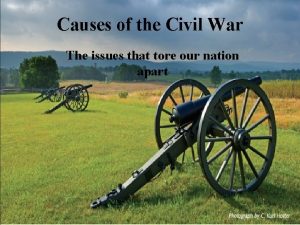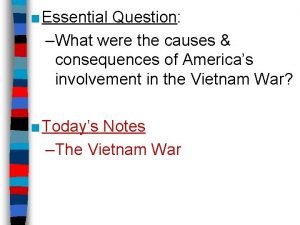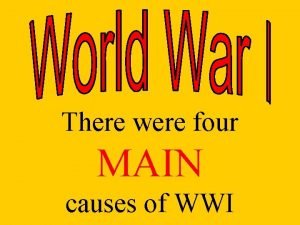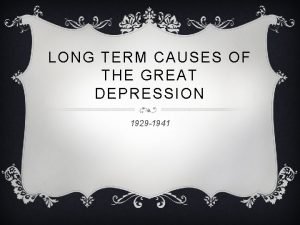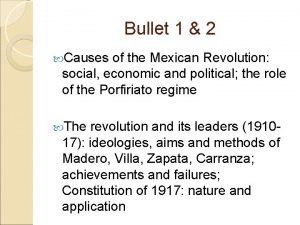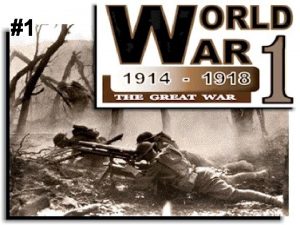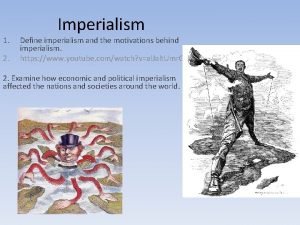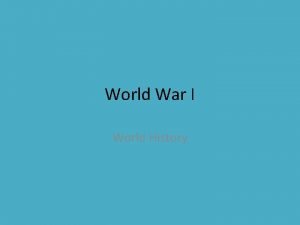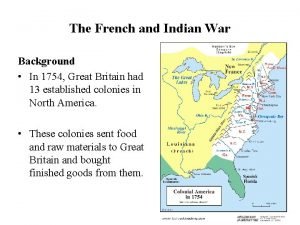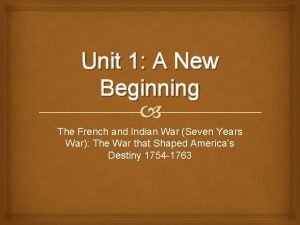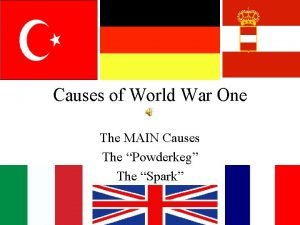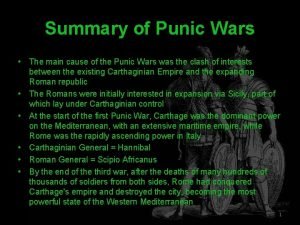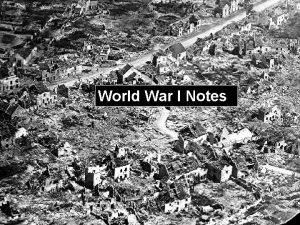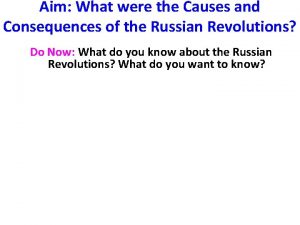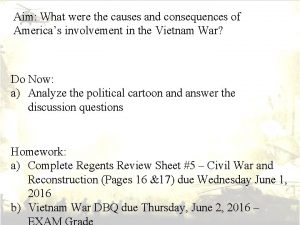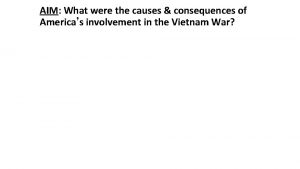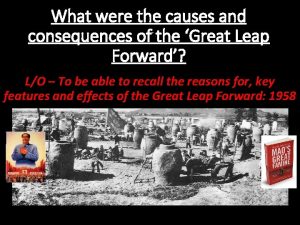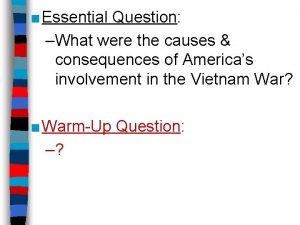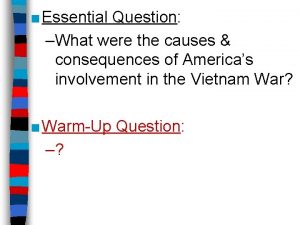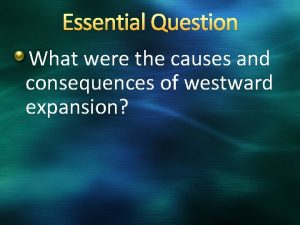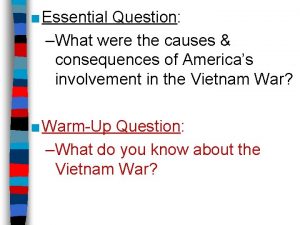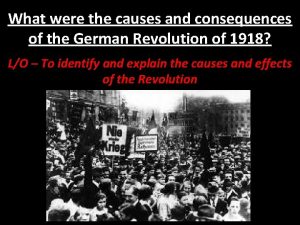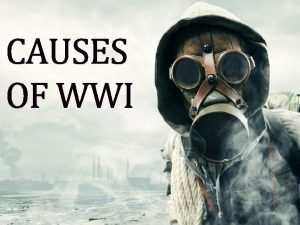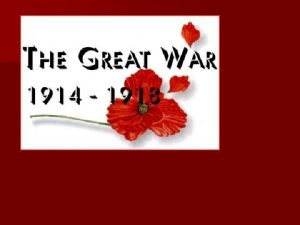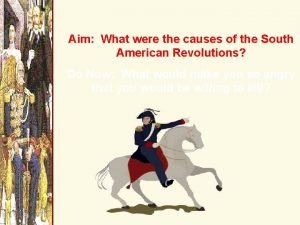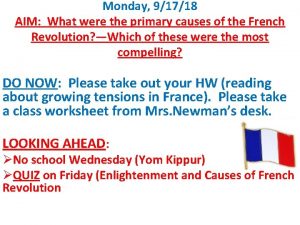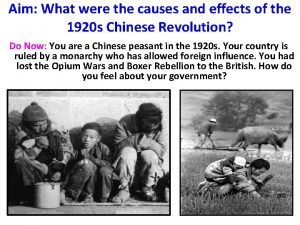Aim 73 What were the causes consequences of


















- Slides: 18

■ Aim #73: What were the causes & consequences of America’s involvement in the Vietnam War? ■ Do now! ■ 1. Read the excerpt from the “Vietnamese Declaration of Independence” ■ 2. Based on the hw, what seems to be the general sentiment towards the war in Vietnam. Be ready to discuss your answers.

(I) BACKGROUND ON VIETNAM a. Vietnam wanted their independence from France b. Ho Chi Minh was Communist leader (US didn’t help because he was a communist) c. (1954) France lost battle of Dien Bien Phu and abandoned Vietnam divided into communist N. Vietnam and S. Vietnam supported by U. S.

(II) US INVOLVEMENT IN VIETNAM a. US supported unpopular leader of. S. Vietnam named Diem b. Domino theory: fear that if one country fell to communism, others in area would too c. JFK increased military advisors and troops in Vietnam d. (1964) Gulf of Tonkin incident: LBJ claimed US ship was attacked by N. Vietnamese 1. Led to Congress issuing a “blank check” for LBJ to send more troops into Vietnam d. Tet Offensive (1968) surprise attack by N. Vietnam during the Vietnamese New Year http: //www. history. com/topics/vietnam-war/tet-offensive

The Escalation of the Vietnam War



The U. S. military used a variety of tactics to fight the war in Vietnam The air force bombed villages & supply lines (Ho Chi Minh Trail)

The U. S. military used a variety of tactics to fight the war in Vietnam The military used napalm to destroy villages & pesticides (Agent Orange) to destroy crops

https: //youtu. be/yyr. Tv. Ikxym 8

“My Lai Massacre” 1968 TV broadcasts reported body counts, atrocities, declining troop morale, & lack of gains in the war Television made Vietnam a “living room war”

(III) PROBLEMS JOHNSON FACED DURING WAR a. Credibility gap: govt. and military reports of the war’s progress did not match what Americans saw on tv 1. 1 st “Living Room” war (Americans saw casualty counts on tv) b. Doves: belief that $ spent on Vietnam could have been put to better use addressing problems in the U. S. 1. Great opposition from college campuses Kent State shootings: Protesting Vietnam This photograph won the Pulitzer Prize 4 students died after being shot by the Ohio National Guard

Protesting the Vietnam War Since 1965, U. S. troops had been in Vietnam… but 1968 was the height of the Vietnam War & the year of the disastrous Tet Offensive

Protesting the Vietnam War Students protested the killing of civilians & the draft, especially the large numbers of African Americans, Hispanics, & highschool dropouts

Nixon wanted “peace with honor” in Vietnam

(IV) Vietnamization a. Nixon’s policy of gradually removing US troops b. US would then provide $, weapons and training necessary to S. Vietnamese to win war on their own c. Nixon Doctrine: all Asian allies would receive US support, but not with forces d. Pentagon Papers: study published in NY Times about war


(V)The Impact of the Vietnam War a. The conflict in Vietnam was the longest & most divisive war in U. S. history b. War Powers Resolution: restricted President’s power in wartime (most actions need congressional approval) Of the 3. 3 million U. S. soldiers who served: ▪ 58, 000 were killed ▪ 303, 000 were wounded ▪ 15% were diagnosed with posttraumatic stress disorder after the war ▪ Many vets faced hostility from other U. S. citizens when they returned home John Mc. Cain greeting President Nixon (he was a POW for 5 years)

Questions: 1. How reasonable does the cartoonist think the 2 “strategists” are. Support your answer with details. 2. What alternatives to the strategies proposed in the cartoon do you think the US might have considered in Vietnam during the mid 1960 s? https: //youtu. be/IPPa. ZU 18 r. Ug Now…please flip over do now and answer discussion questions
 Rising food prices causes and consequences
Rising food prices causes and consequences Ultimate vs proximate causation
Ultimate vs proximate causation Proximate and ultimate causes of behaviour
Proximate and ultimate causes of behaviour What were the 4 main causes of the civil war
What were the 4 main causes of the civil war What were the causes and effects of the vietnam war
What were the causes and effects of the vietnam war The causes of the korean war
The causes of the korean war Simulateries
Simulateries What were the long term causes of the great depression
What were the long term causes of the great depression What were the causes of the mexican revolution
What were the causes of the mexican revolution Persian wars cause
Persian wars cause What were the causes of imperialism
What were the causes of imperialism Central powers wwi
Central powers wwi Causes of imperialism
Causes of imperialism Cause of colonialism
Cause of colonialism Causes of french and indian war
Causes of french and indian war New beginning in french
New beginning in french Main causes of ww1
Main causes of ww1 Punic reforms
Punic reforms Mania causes of ww1
Mania causes of ww1



